You searched for: 数字货币游戏,加密货币游戏,数字币游戏,ust博彩游戏,【www.2266.com,复制打开网址】,unit泰达币博彩网站,区块链游戏排名,区块链游戏nft,区块链游戏平台,nft游戏有哪些,nft是什么游戏,以太坊游戏,区块链游戏赚钱网站,币圈游戏,区块链博彩平台,网址kaefhfkccdckbghcd
<< Previous | Displaying results 201-250 of 1751 for "数字货币游戏,加密货币游戏,数字币游戏,ust博彩游戏,【www.2266.com,复制打开网址】,unit泰达币博彩网站,区块链游戏排名,区块链游戏nft,区块链游戏平台,nft游戏有哪些,nft是什么游戏,以太坊游戏,区块链游戏赚钱网站,币圈游戏,区块链博彩平台,网址kaefhfkccdckbghcd" | Next >>
-
The British Policy of Appeasement toward Hitler and Nazi Germany
ArticleIn the 1930s, Prime Minister Neville Chamberlain and the British government pursued a policy of appeasement towards Nazi Germany to avoid war. Learn more.
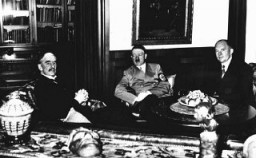
-
Franklin Delano Roosevelt
ArticleFranklin D. Roosevelt was 32nd president of the US. Learn about the domestic and international challenges FDR faced as president during World War II.
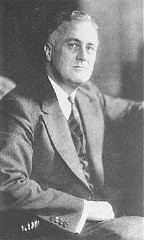
-
Ritchie Boys
Article“Ritchie Boys” is a term used for American soldiers who trained at Camp Ritchie during World War II. Several thousand were Jewish refugees from Europe. Learn more.
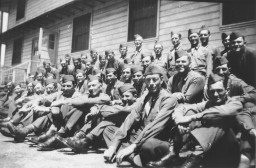
-
Poster calling for a boycott of German goods
PhotoPoster calling for a boycott of German goods. Issued by the Jewish War Veterans of the United States. New York, United States, between 1937 and 1939.

-
Eternal flame
PhotoVisitors view the eternal flame in the Hall of Remembrance at the United States Holocaust Memorial Museum.
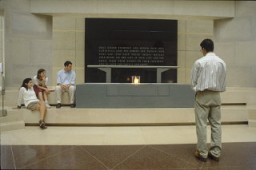
-
The Great Depression
Media EssayThe “Great Depression” is the term used for a severe economic recession which began in the United States in 1929. By 1933, nearly 15 million Americans were unemployed.
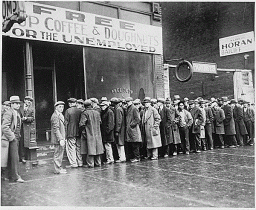
-
14th Street exterior
PhotoDetail of the 14th Street facade of the United States Holocaust Memorial Museum. Washington, DC, April 2003.
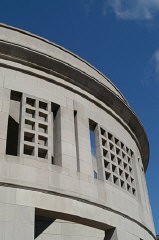
-
Charles Coughlin
PhotoFather Charles Coughlin, leader of the antisemitic Christian Front, delivers a radio broadcast. Detroit, United States, March 11, 1935.
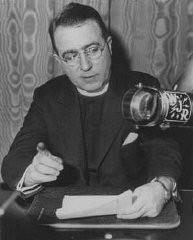
-
Antisemitic isolationist publication
PhotoAn antisemitic isolationist publication in the United States, ca. 1938–41. It blames Jews and Jewish interests for the war and advocates the boycott of Jewish businesses.
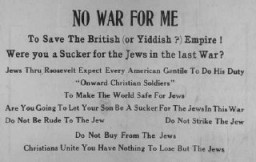
-
Arriving at the Fort Ontario refugee shelter
PhotoJewish refugees from Europe arrive at the emergency refugee shelter at Fort Ontario, in the United States. A father, holding his daughter, checks his tags. Oswego, New York, United States, August 4, 1944.
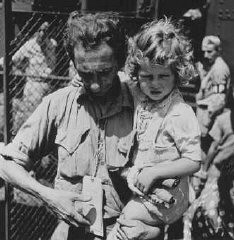
-
Henry Morgenthau, Jr., greets Jewish refugees en route from Shanghai to Israel
PhotoHenry Morgenthau, Jr., treasury secretary in the Roosevelt administration and later chairman of the United Jewish Appeal, greets Jewish refugees en route from Shanghai to Israel. New York, United States, March 2, 1949.

-
American Jewish Joint Distribution Committee and Refugee Aid
ArticleA relief organization, the American Jewish Joint Distribution Committee (JDC or Joint) was established in 1914. Learn about its activities before, during, and after WWII.
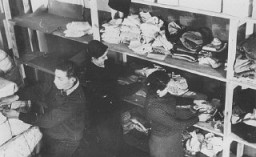
-
Fort Ontario refugee shelter
PhotoAmerican military police admit a father and daughter, both displaced persons, to the refugee shelter at Fort Ontario. Oswego, New York, United States, after August 4, 1944.
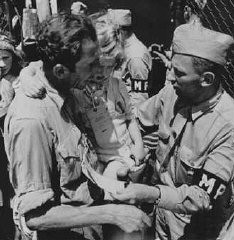
-
Insignia of the 6th Armored Division
PhotoInsignia of the 6th Armored Division. "Super Sixth" became the nickname of the 6th Armored Division while the division was training in the United States, apparently to symbolize the division's spirit.
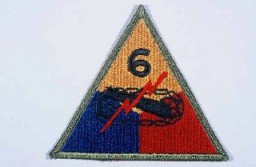
-
Insignia of the 26th Infantry Division
PhotoInsignia of the 26th Infantry Division. The 26th Infantry Division, the "Yankee" division, was so nicknamed to recognize the six New England states from whose National Guard units the division was raised during World War I.
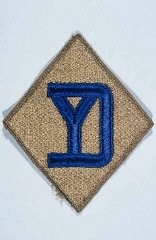
-
Insignia of the 10th Armored Division
PhotoInsignia of the 10th Armored Division. The "Tiger Division" nickname of the 10th originates from a division-wide contest held while it was training in the United States, symbolizing the division "clawing and mauling" its way through the enemy.
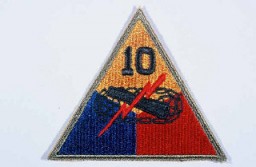
-
Father Charles Coughlin
PhotoFather Charles Coughlin, leader of the antisemitic Christian Front, delivers a radio broadcast. United States, February 4, 1940.
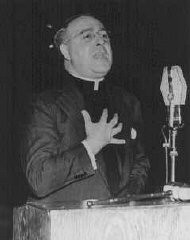
-
Flags of liberating divisions
PhotoFlags of liberating divisions are presented during a ceremony at the Museum's Tribute to Holocaust Survivors: Reunion of a Special Family. This tribute was one of the United States Holocaust Memorial Museum's tenth anniversary events. Washington, DC, November 2003.

-
Austrian Jewish children rescued by Eleanor and Gilbert Kraus
PhotoAustrian Jewish children being transported to the United States by Eleanor and Gilbert Kraus perform a life jacket drill aboard the ship President Harding. June 1939.
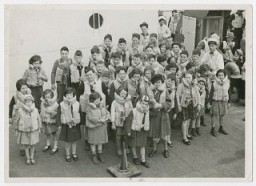
-
Freedom of Press
Photo(1941-1942) Crowded newsstands in the United States such as these held journals representing various political parties and ideologies. Americans had access to many different perspectives about what was happening at home and abroad during the war.
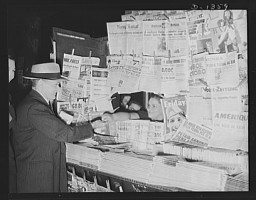
-
The UN Diplomatic Conference on the establishment of an International Criminal Court
PhotoThe United Nations Diplomatic Conference of Plenipotentiaries on the Establishment of an International Criminal Court opened a five week session on June 15, 1998, in Rome, Italy.
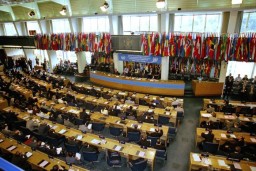
-
Aron and Lisa Derman: Family Photographs
Media EssayWith the end of World War II and collapse of the Nazi regime, survivors of the Holocaust faced...
-
"What shall be done with the war criminals?"
ArtifactCover of booklet titled "What Shall Be Done with the War Criminals?" Published by the United States Armed Forces Institute, this was one of a series of 42 pamphlets created by the U.S. War Department under the series title "G.I. Roundtable." From 1943-1945, these pamphlets were created to "increase the effectiveness of the soldiers and officers and fighters during the war and as citizens after the war." Many of the pamphlets addressed the possibilities of a postwar world.
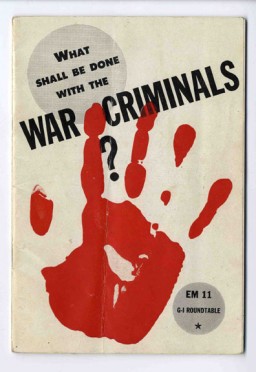
-
Stephen S. Wise and Bernard Deutsch
PhotoAmerican Zionist leader Rabbi Stephen S. Wise (right) with Bernard Deutsch, president of the American Jewish Congress, before making a protest to President Franklin D. Roosevelt against religious persecution in Germany. New York, United States, March 22, 1933.
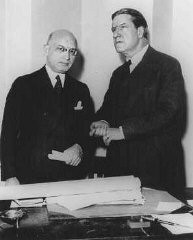
-
Insignia of the 90th Infantry Division
PhotoInsignia of the 90th Infantry Division. Called the "Tough Ombres," the 90th Infantry Division was raised from draftees from the states of Texas and Oklahoma during World War I. The divisional insignia incorporates the letters "T" and "O" to symbolize both states. These letters later yielded the nickname "Tough Ombres," symbolizing the esprit de corps of the unit. The 90th was also sometimes called the "Alamo" division during World War II.
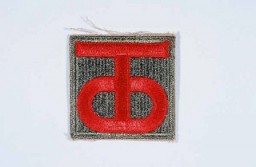
-
Insignia of the 101st Airborne Division
PhotoInsignia of the 101st Airborne Division. The nickname of the 101st Airborne Division, "Screaming Eagles," originates from the division's insignia, a bald eagle on a black shield. "Old Abe" was the eagle mascot of a Wisconsin regiment during the Civil War. The 101st was formed as a reserve unit in Wisconsin shortly after World War I and included "Old Abe" as part of the division's insignia.

-
Insignia of the 103rd Infantry Division
PhotoInsignia of the 103rd Infantry Division. The 103rd Infantry Division, the "Cactus" division, is so called after the 103rd's shoulder patch, a cactus in a gold circle. The cactus is representative of the states whose troops formed the unit in the early 1920s: Arizona, Colorado, and New Mexico.

-
Lion Feuchtwanger in New York
PhotoAuthor Lion Feuchtwanger in New York, November 17, 1932. Feuchtwanger's 1930 novel Erfolg (Success) provided a thinly veiled criticism of the Beer Hall Putsch and Hitler's rise to leadership in the Nazi Party. He was targeted by the Nazis. After the Nazi takeover on January 30, 1933, his house in Berlin was illegally searched and his library was plundered during his lecture tour in the United States.
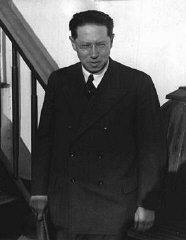
-
Insignia of the 36th Infantry Division
PhotoInsignia of the 36th Infantry Division. The 36th Infantry Division, the "Texas" division, was raised from National Guard units from Texas and Oklahoma during World War I. The "T" in the division's insignia represents Texas, the arrowhead Oklahoma. The division was also sometimes called the "Lone Star" division, again symbolizing its Texas roots.
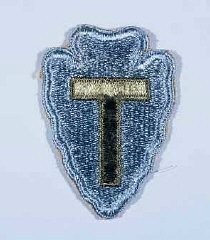
-
Insignia of the 29th Infantry Division
PhotoInsignia of the 29th Infantry Division. "Blue and Gray" was coined as the nickname of the 29th Infantry Division by the division's commander during World War I. The name commemorates the lineage of the mid-Atlantic states' National Guard units that formed the division, many with service on both sides during the Civil War.

-
Rufus Jones and Clarence Pickettof the American Friends Service Committee (AFSC)
PhotoRufus Jones (seated) and Clarence Pickett were chairman and executive secretary of the American Friends Service Committee (AFSC), respectively. They are pictured here at a Quaker meeting in Philadelphia. The AFSC assisted Jewish and Christian European refugees. Philadelphia, United States, January 22, 1943.
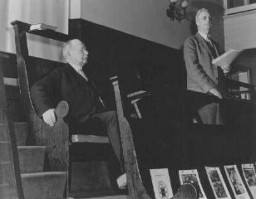
-
Dust Bowl
PhotoA farmer and his sons walk in the face of a dust storm. Cimarron County, Oklahoma. 1936
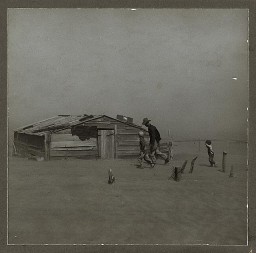
-
Benjamin Meed and Harvey Meyerhoff pose by the cornerstone for the Museum building
PhotoBenjamin Meed (right) and Harvey Meyerhoff stand next to the cornerstone for the United States Holocaust Memorial Museum. In October 1988, President Ronald Reagan spoke at a special ceremony held when the cornerstone of the Museum was laid, with construction beginning in July 1989 and ending in April 1993. Washington, DC, 1988.
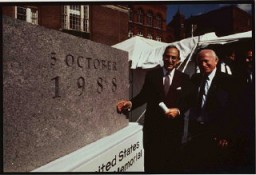
-
Breadline
PhotoThis photo of a Depression-era bread line was taken by Dorothea Lange at the White Angel Jungl...
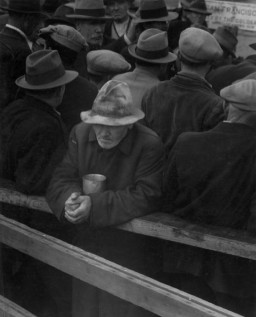
-
Anti-Nazi protest in New York's Madison Square Garden
PhotoOn the day of book burnings in Germany, massive crowds march from New York's Madison Square Garden to protest Nazi oppression and anti-Jewish persecution. New York City, United States, May 10, 1933.
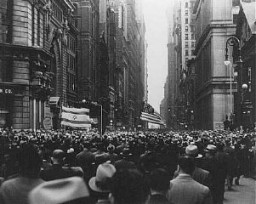
-
International Criminal Court
Timeline EventJuly 17, 1998. On this date, the Rome Statute established the International Criminal Court, a permanent judicial body to try genocide and war crimes.

-
Instructions posted during Japanese American relocation
PhotoA notice posted on a wall in San Francisco, California, lists “evacuation” instructions for the area’s Japanese American residents, 1942. They were deported, first to temporary “assembly centers,” and from there to relocation centers in remote areas of the United States.
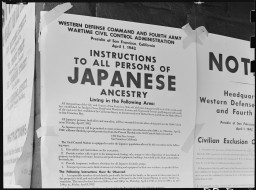
-
Poster depicting the Statue of Liberty and flags of Allied Nations
ArtifactPoster titled “The United Nations Fight For Freedom.” It was one of many posters produced by the Office of War Information, the United States’s official propaganda agency during World War II. Canadian-American commercial artist Steve Broder (1902-1992) designed this work to bolster confidence in the Allied war effort against the Axis Powers (Nazi Germany, Fascist Italy, and Imperial Japan). It depicts the 30 flags of countries that signed the Declaration by the United Nations and declared war on the…
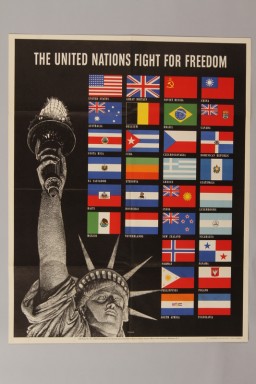
-
A notice sent by the American Consulate General in Berlin regarding immigration visas
DocumentA notice sent by the American Consulate General in Berlin to Arthur Lewy and family, instructing them to report to the consulate on July 26, 1939, with all the required documents, in order to receive their American visas. German Jews attempting to immigrate to the United States in the late 1930s faced overwhelming bureaucratic hurdles. It was difficult to get the necessary papers to leave Germany, and US immigration visas were difficult to obtain. The process could take years.
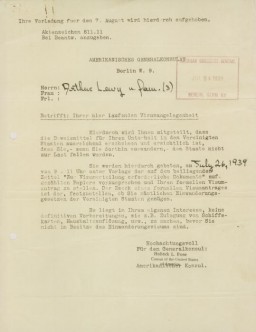
-
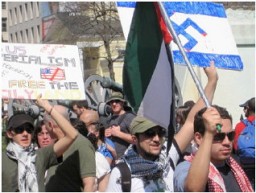
-
Celebrating Shelly's wedding
PhotoBlanka (right) with her daughter, Shelly, after Shelly's wedding. New York, 1974.
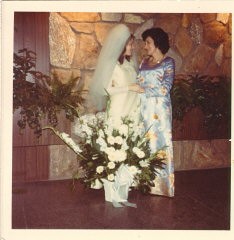
-
Aron and Lisa Derman: Oral History Excerpts
Media EssayIn 1942, Aron Derman and Lisa Nussbaum escaped deportation from the Grodno ghetto with the help of Tadek Soroka, a non-Jewish Pole. Aron and Lisa—aged 19 and 15—joined the armed Jewish resistance. As partisans, they f...
-
Wool Bedcover
ArtifactFollowing the Soviet occupation of Lithuania, the Lifszyc family began to search for ways to leave the country. David Lifszyc obtained a Curacao visa from the Dutch consulate. He also obtained an American visa because he was included on a list of distinguished rabbis submitted to the State Department by the Agudat Israel of America. After obtaining Soviet exit visas, the Lifszycs purchased tickets for Vladivostok on February 5, 1941. They started for Moscow, where they received Japanese transit visas. This…

-
Insignia of the 99th Infantry Division
PhotoInsignia of the 99th Infantry Division. The 99th Infantry Division, the "Checkerboard" division, gained its nickname from the division's insignia. The insignia was devised upon the 99th's formation in 1942, when the division was headquartered in the city of Pittsburgh. The blue and white checkerboard in the division's insignia is taken from the coat of arms of William Pitt, for whom Pittsburgh is named. The division was also known as the "Battle Babies" during 1945, a sobriquet coined by a United Press…
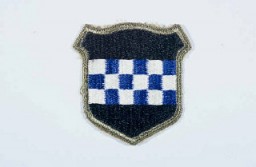
-
Between the Weedpatch
Photo"Between Weedpatch and Lamont, Kern County, California. Children living in camp" by Dorothea Lange, April 20, 1940.
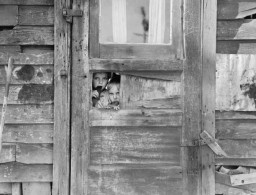
-
Portraits of Martha and Waitstill Sharp
PhotoPortraits of Martha and Waitstill Sharp from an unknown newspaper. Published before they left for Europe on a relief mission with the Unitarian Service Committee.
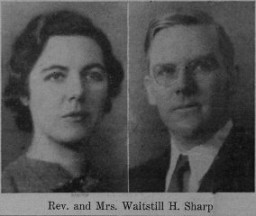
-
Graduation as a pediatric nurse
PhotoBlanka (middle row, third from right) graduates to become a pediatric nurse. December 1947.
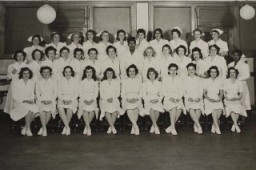
-
Wedding anniversary in New York
PhotoBlanka and Harry celebrate their wedding anniversary in a New York café. At the time, Blanka was expecting their first child.
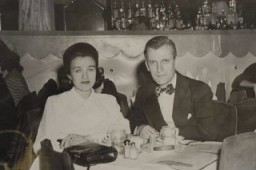
-
Harry teaching his granddaughter how to swim
PhotoHarry teaching granddaughter Alexis Danielle how to swim, probably in San Diego, California.

